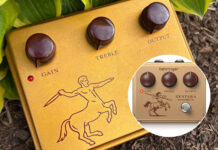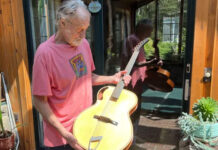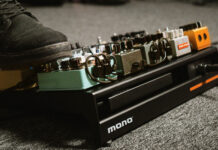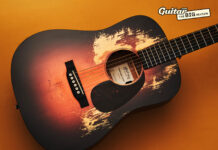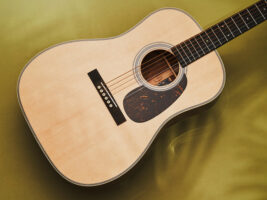
A love letter to the acoustic guitar: thank you from my calloused fingers
As a guitar player of twenty years or so, there’s one instrument that I keep coming back to: the acoustic guitar. Graduating from the half-size classical guitar I started on, my eyes were set on a solid-body electric and a high gain amplifier that felt like a natural progression for me as a young rocker.
READ MORE: More Unusual First Guitars That Rock Stars Started Their Careers On
Instead I was presented with a dreadnought acoustic, as primarily a test of my commitment to the instrument, but an unknowingly practice tool that I would come back to time and again. Much like walking with ankle weights or cardio in the swimming pool, the acoustic guitar can serve as a form of resistance training.
This makes movement and technique more difficult, and while it boxes you into building muscle, it’s also training you to listen to what sounds right at its core, i.e. tuning, fretting and timing for consistency and dynamic. For the hours of practice I spent on this guitar on those formative years of playing, I want to say thank you.
For any beginners reading, that acoustic guitar you’re struggling with is doing you a lot of good, and for more experienced players, it might be good to get back into the habit of acoustic practice to keep those chops up!
This is for a few reasons, the first being that while those of us who grew up aspiring to be amplified rock gods, the electric guitars we strived after often had smaller gauge strings, coupled with a lower action to make it easier to bend notes and jump around the fretboard. The acoustic guitar we had kicking around the house usually had some heavy and old strings, the higher action making it an overall more difficult beast to wrangle.
But here’s the kicker: having to get my practice routines right on an acoustic guitar gave me more dynamic ability in both my picking and fretting hand, as well as calloused fingers and muscles in my arms and hands that made my eventual flitting around the neck of an electric guitar feel like child’s play.
Image: Adam Gasson
Harder to play
Conventionally, in E Standard, an electric guitar might be strung with .009 or .010 gauge strings, often nickel wound at the highest end, acoustic guitars instead using steel or bronze strings and often being .012 or .013 in size in the same tuning. This means it’s a little more difficult to fret, to bend notes and barre chords, but this can form an important part of your practice routine.
Improperly fretted notes can buzz and ring, requiring you to really push down and move between every note like you mean it. Lighter gauges allow a little more freedom for bending, but your bends on an acoustic really need to be bent right up to the intended pitch, an acoustic guitar often being played without additional effects or other processing to mask your imperfect playing. Bent notes might warble and ring until you get them right, and you best believe your acoustic guitar won’t let you get away with it like an overdriven electric guitar.
Image: Adam Gasson
Can’t hide behind effects
This leads me to my second point, the acoustic guitar generally being a mostly unprocessed instrument, meaning there’s no distortion, delay or chorus to make you sound better than you are! Effects are good for augmenting a great performance, and what makes for a great performance? Consistent practice.
Distortion and drive will compress and attenuate your playing which might lead to inconsistent picking, but the acoustic guitar will leave your playing exposed, forcing you to focus on accuracy, consistency and tonality. You’re also forced to assess the relationship between your picking and fretting hand. Buzzing frets or scratchy picking are laid bare on your trusty steel string acoustic.
Image: Adam Gasson
Campfire test
All of this is in the pursuit of practicing enough to sound good on an acoustic guitar, and this isn’t entirely unlike the renowned “campfire test” for songwriters. The “campfire test” is simple: a good song will work whether it’s performed with a full backing band or around a campfire with just an acoustic guitar and a vocal. While the additional layers and harmony are there to expand on the emotional and musical impact of your song, if they instead act as a crutch for your song, well, you might have some work to do.
Practicing on an acoustic guitar borrows from this same thought process, stripping away everything except your skills, timing and talent, and forces you to focus on your playing without augmentation. Your playing shouldn’t rely on effects as a general rule of thumb, though we’ll exclude players like Kevin Shields from this. As you were, shoegazers.
All of this is to say, that while I struggled, fumbled and cussed through hours of practice with my acoustic guitar, every minute has made me a better guitar player because at a foundational level it taught me to play every note like I mean it, bend right up to pitch and beyond, and gave me great dynamic control of my picking hand. Without distortion and overdrive hiding fumbled picking, or reverb and chorus clouding my timing, I was able to focus on my technique and playing, and you can ensuring you’re getting the most out of your practice. And hey, while there’s a case to be made for practicing with the gear you’ll play live, the acoustic guitar will always be there to go back to; and somehow it’ll never seem to get easier to wrangle.
The post A love letter to the acoustic guitar: thank you from my calloused fingers appeared first on Guitar.com | All Things Guitar.
Source: www.guitar-bass.net

